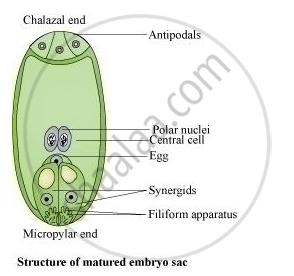Advertisements
Advertisements
Question
Explain the events upto double fertilisation after the pollen tube enters one of the synergids in an ovule of an angiosperm.
Solution
The events which occur during double fertilization are:
-
Two male gametes are released by the pollen tube into the cytoplasm of synergid.
-
One of these male gametes moves towards the egg cell and fuses with the nucleus. This process is called syngamy and results in the formation of a diploid cell, zygote,which eventually forms an embryo.
-
The other male gamete moves towards the polar nuclei located in the central cell and fuses with them to form a triploid primary endosperm nucleus (PEN). This process is called triple fusion.
-
Since two types of fusion, syngamy and triple fusion, take place here, the phenomenon is called double fertilisation.

APPEARS IN
RELATED QUESTIONS
Name the parts of an angiosperm flower in which development of male and female gametophyte take place.
In a flowering plant a microspore mother cell produces four male gametophytes while a megapore mother cell forms only one female gametophyte. Explain
Read the statement and answer the questions that follow.
A flower of brinjal has 520 ovules in its ovary. However, it produces a fruit with only 480 viable seeds.
(a) What could have prevented the rest of the 40 ovules from maturing into viable seeds? Explain giving a reason.
(b) Describe the development of a dicot embryo in a viable seed.
(c) Why certain angiospermic seed albuminous while others are exalbuminous? Explain.
Give an example of an angiosperm seed that has a perisperm. Name the part the perisperm develops from.
Give a reason for the Following:
Pollen grains of wind-pollinated flowers are produced in large quantities.
A typical flower has ______ different kinds of whorl.
Science of cultivation, breeding, marketing and arrangement of flowers is called ______.
Pollen grains are well preserved as fossils because of the presence of ______
Which of the following statement is incorrect?
Male and female reproductive structures of the angiosperms are ______.
